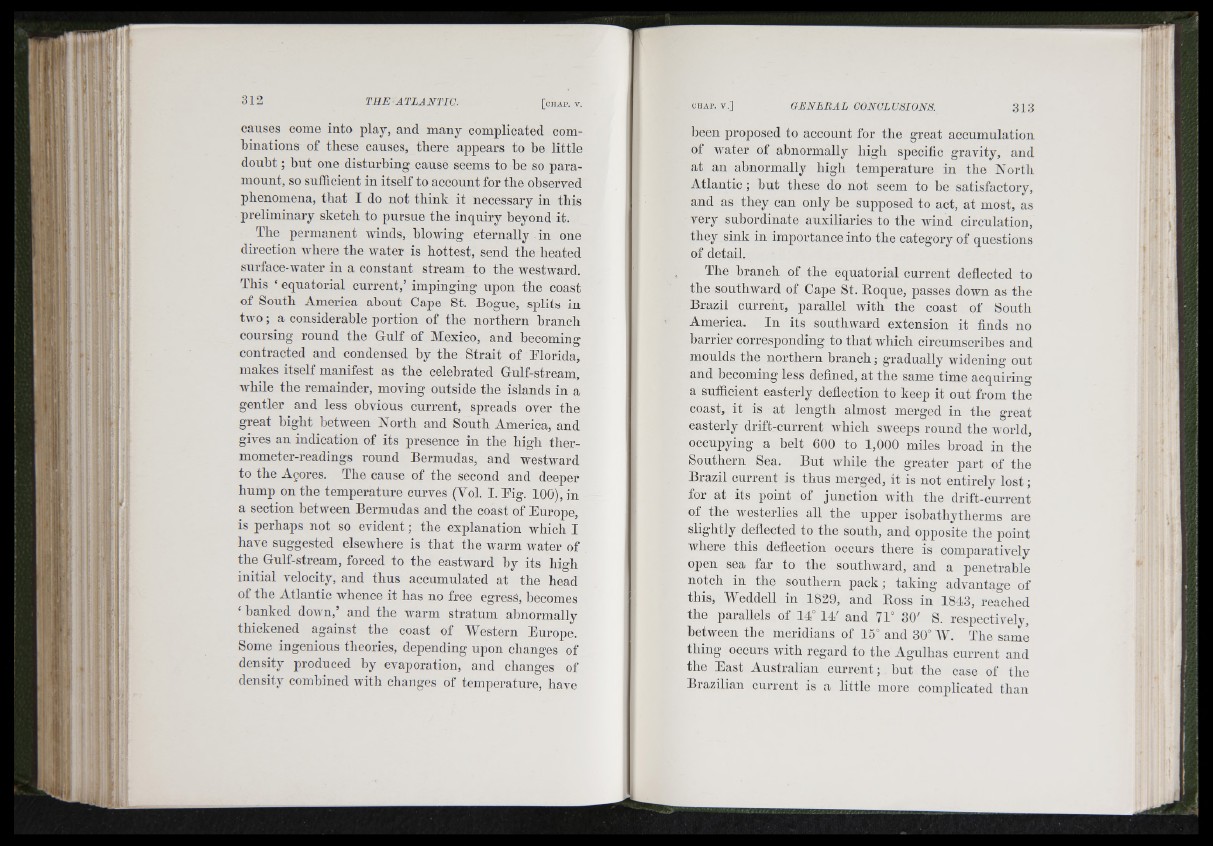
T
causes corne into play, and many complicated combinations
of tbese causes, tbere appears to be little
doubt ; but one disturbing cause seems to be so paramount,
so sufficient in itself to account for tbe observed
pbenomena, tbat I do not tbink it necessary in tbis
preliminaiy sketch to pursue tbe inquiry beyond it.
Tbe permanent Avinds, bloAviug eternally in one
direction Avbere tbe Avater is hottest, send the heated
snrface-Avater in a constant stream to the AvestAvard.
This ‘ equatorial current,’ impinging upon the coast
of South America ahout Cape St. Bogue, splits in
tAvo ; a considerable portion of the northern hranch
coursing round the Gulf of Mexico, and becoming
contracted and condensed hy the Strait of Florida,
makes itself manifest as the celebrated Gulf-stream,
Avhile the remainder, moving outside the islands in a
gentler and less obvious current, spreads over tbe
great bigbt between North and South America, and
gives an indication of its presence in the high ther-
mometer-readings round Bermudas, and westward
to the Açores. The cause of the second and deeper
hump on the temperature curves (Vol. I. Fig. 100), in
a section between Bermudas and the coast of Furope,
is perhaps not so evident ; the explanation which I
have suggested elscAvhere is that the warm water of
the Gnlf-stream, forced to the eastward by its high
initial velocity, and thus accumulated at the head
of the Atlantic whence it has no free egress, becomes
‘ banked doAvn,’ and tbe warm stratum abnormally
thickened against tbe coast of Western Europe.
Some ingenious theories, depending upon changes of
density produced by evaporation, and changes of
density combined with changes of temperature, have
l)een proposed to account for tbe great accumulation
of Avater of abnormally bigli specific gravity, and
at an abnormally high temperature in tbe North
Atlantic; but tliese do not seem to be satisfactory,
and as they can only be supposed to act, at most, as
very subordinate auxiliaries to the wind circulation,
tbey sink in importance into tbe category of questions
of detail.
The branch of tbe equatorial current deflected to
the southward of Cape St. Roque, passes down as the
Brazil current, parallel Avith tbe coast of South
America. In its southward extension it finds no
barrier corresponding to tbat which circumscribes and
moulds the northern branch; gradually widening out
and becoming less defined, at the same time acquiring
a sufficient easterly deflection to keep it ont from the
coast, it is at length almost merged in the great
easterly drift-current Avhich SAveeps round the AA orld,
occupying a belt 600 to 1,000 miles broad in tbe
Southern Sea. But while tbe greater part of tbe
Brazil current is thus merged, it is not entirely lo s t;
for at its point of junction AAutb tbe drift-current
of the westerlies all the upper isobatbytberms are
slightly deflected to the south, and opposite the point
where this deflection occurs there is comparatively
open sea far to the sonthAvard, aud a penetrable
notch in the southern pack; taking advantage of
this, Weddell in 1829, and Ross in 1813, reached
the parallels of IV IV and 71° 30' S. respectively,
between tbe meridians of 15° and 30° W. Tbe same
tiling occurs Avitb regard to tbe Agulhas current and
tbe East Australian current; but tbe case of tbe
Brazilian current is a little more complicated tban